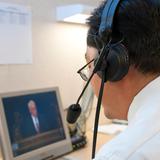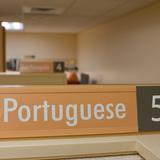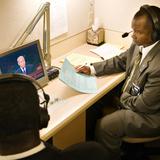(This release was updated on 1 April 2011) When asked how he feels about his colleagues, Brad Lindsay says a lot with just three words. “I love them,” he states, drawing a wide grin. Lindsay is manager of interpretation services for The Church of Jesus Christ of Latter-day Saints, where he works to ensure the Church’s twice-yearly general conference is translated into 92 different languages for broadcast around the world.
The Church’s culturally and linguistically diverse membership allows it to recruit literally hundreds of interpreters to accomplish the colossal task. The interpretation of general conference is immense. Global broadcasts reach millions of listeners, making it one of the largest interpretation efforts in the world.
| Indonesian interpreter Edwin Tandiman translates a general conference talk. 2010 Intellectual Reserve, Inc. All rights reserved | 1 / 6 |
While most interpreters work in the Conference Center in Salt Lake City, others are situated in a dozen other translation offices around the world. Not all are professionals. They are often students or immigrants translating from English into their native tongues. Even Church members who have served in international missions participate.
Lindsay and his colleagues draw on their professional networks to find those with the right skills, background and other attributes it takes to be an interpreter. They’ll often use word-of-mouth and occasionally tap existing team members to suggest potential recruits.
Naturally, language mastery and ability to enunciate clearly are a must when interpreting general conference. Interpreters must also keep two conversations — in two different languages — going on in their head at the same time. “With interpretation, there is no one thing that we look for,” Lindsay said. “It is a combination of things that makes for a good interpreter.”
In addition to language proficiency, effective interpretation includes transmitting the emotion and intent of the speaker standing at the pulpit. “What we are translating is not our own message,” Lindsay said. “The message comes from the speakers, so we try to find people that can share that message effectively.”
Mongolian interpreter Chuluun Walker has been interpreting general conference for nine years. She still remembers her first time interpreting general conference.
“When I came to America, I was going to Brigham Young University and was also working at the Missionary Training Center. They needed some people to help with interpretation and I decided to try it out,” Walker said.
“It was very scary the first time and I still get scared. It’s a big responsibility. I have to prepare myself spiritually and mentally, and I think that helps,” she added.
While interpreters draw on their own training and experience, the Church holds as many as 10 trainings a year for both new and seasoned interpreters.
“Interpretation and translation is an art form,” said Lindsay. “People have to continually practice and rehearse, so we provide opportunities here in Salt Lake and around the world. We give interpreters scenarios and situations. We run them through the gauntlet.”
At trainings, interpreters are given tips to help them navigate the nuances of language and are encouraged to tune in to the emotion coming from the pulpit when they interpret.
However, interpretation requires more than experience, talent and training. "Interpretation is a spiritual gift that our interpreters need to have," said Jeff Bateson, director of translation for the Church. “We go to great lengths to do whatever we can to help them prepare spiritually.”
“We train our interpreters to follow the emotions of the speaker,” Lindsay said. “If the speaker is being forceful, we teach the interpreters to also be forceful. If the speaker is emotional, we teach them to pull back a little bit.”
There are no second chances when interpreting live. “We have a one-time shot at it,” Lindsay said. “When we interpret it has to be good, and it has to be good the first time.”
Consequently, preparation for general conference begins months in advance. In all, approximately 800 people, many of them volunteers, work together before and during general conference to finalize schedules, test equipment and finally deliver the interpretation live to millions of listeners around the world.
“There’s a storm that happens before the calm,” Lindsay said, referring to the months leading up to the general conference broadcast. Interpreters must also prepare personally for what they feel is primarily a spiritual work.
Fabio Sagebin is a Portuguese interpreter who has been doing interpretation for about 15 years. Though general conference is now translated live in his homeland of Brazil, he still does regular Portuguese translation in the Conference Center for other events.
“Preparation is a key element for interpretation,” Sagebin said. “You must prepare personally by living the best life that you can live, but there is also a lot of homework that you need to do. You need to do a lot of reading and know the scriptures and Church doctrine.”
“When general conference is over, I feel thankful for the opportunity of being part of it. I also feel relief because there is a lot of preparation to get to that point,” he added.
When general conference finally arrives, team members meet before each session to review arrangements, exchange last-minute updates and join together in prayer. Then they separate, the interpreters making their way to one of 58 language-specific interpretation booths.
Each booth is equipped with a desk and a monitor relaying images from the Conference Center’s massive pulpit. A panel equipped with audio controls divides the desk into two workstations and allows the interpreters to adjust the volume of the proceedings and his or her voice that is transmitted to their headsets.
“I don’t think that there is another place in the world that has as fine of a facility as we have here,” Lindsay said. “The Church has done a marvelous job in providing the equipment and facilities necessary to get its messages out.”
Interpreters generally work in groups of four. While one person interprets, another sits alongside ready to step in if needed, ensuring the interpretation is uninterrupted. Two other interpreters sit just outside the door observing their colleagues through a glass panel and waiting for their assigned opportunity to interpret.
“In the area around my booth there are Laotians, Thais and Vietnamese,” said Lao interpreter Keo Brown. “We kind of stick together in one little group and we know each other.”
Each interpreter has his or her own approach to interpretation. Some sit, while others prefer to stand, yet all are anxious to communicate effectively the messages of the speakers at the pulpit.
“I use my hands and I use my face. I smile in the microphone,” said Sagebin. “I use everything the Lord gave me to make sure my voice is at the level of quality needed to inspire the audience. I can imagine somebody in Brazil listening to my voice, and when I do this, somehow it becomes personal.”
Brown, like many others, has been part of interpreting general conference for years. “I can’t remember if I ever missed one,” she said. “There has been maybe once or twice that I have missed doing interpretation in 20 years.”
“To me it is a calling for life. I enjoy it.” Brown continued. “I know that there are some Laotians out there — members, sometimes nonmembers — who watch the conference, and that keeps me going every year.
Download interpreter interviews and b-roll .







